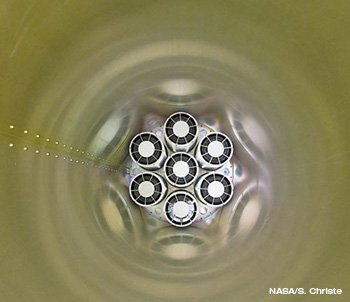
The state-of-the-art optics in FOXSI are part of the telescope’s system for imaging hard X-rays from the sun. The telescope launched in early November.
Nanoflares—relatively faint eruptions from the sun’s surface—were the target for the focusing optics X-ray solar imager (FOXSI) launched aboard a sounding rocket on 2 November from White Sands, N.M. (U.S.A). The six-minute flight provided a brief window for observation that will hopefully give us insight into what causes nanoflares and why the atmosphere of the sun is so much hotter than the surface.
FOXSI is a state-of-the-art X-ray telescope designed to focus incoming X-rays from the sun in a way that has never before been possible. To view the faint nanoflares, the telescope used optics unlike any that have ever looked at hard X-rays from the sun from space.
"FOXSI pointed at multiple targets during it's six-minute flight, including three active regions and the quiet Sun," says Steven Christe, a solar scientist at NASA's Goddard Space Flight Center (U.S.A.). "The FOXSI team is proud to announce that the flight was a success, the payload was recovered intact, and that FOXSI imaged a solar flare for the first time using high energy replicated optics."
Focusing X-rays is harder than focusing visible light, and many systems eschew focusing at all. Non-focusing imagers can provide excellent spatial and spectral resolution, but limited dynamic range and sensitivity—which is a drawback when looking at faint objects like nanoflares. X-ray telescopes that do focus light depend on glancing incidence mirrors, which must be smooth to a high level of accuracy (because the wavelengths are much shorter than visible light) and are labor-intensive to make—and therefore, expensive.
The iridium-coated nickel/cobalt mirrors in FOXSI successfully reflect glancing X-rays towards the imager. Several of these mirrors in combination help collate the X-ray light before funneling it to the detector. The mirrors were made using a replication technique whereby a surface is perfectly polished and mirrors are created off of that surface by nickel-plating it. This process can be repeated, thus, saving time and money.
“This is really the next generation solar hard X-ray telescope we are testing out here,” says Säm Krucker, the principal investigator for FOXSI, and a solar scientist at the University of California, Berkeley (U.S.A.), and University of Applied Sciences Northwestern Switzerland. “The technology we’re using will capture much better images of the sun at this particular range of X-rays.”
